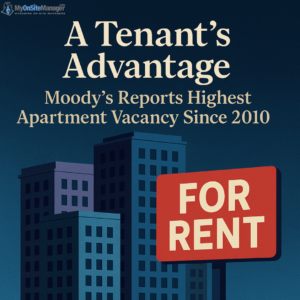In a surprising shift for the multifamily housing sector, Moody’s Analytics reports that the national apartment vacancy rate hit 6.3% in Q1 2025—the highest figure recorded since 2010. For years, renters across the U.S. have grappled with limited supply, rising prices, and fierce competition for leases. But now, cracks are beginning to appear in that landscape.
This trend is not just a seasonal blip. It follows a pattern that started building throughout late 2024, when newly completed developments began hitting the market en masse. What we’re seeing now could mark the early stages of a renter-friendly era, where supply is finally starting to catch up to demand—and even outpace it in some areas.
Key Findings from Moody’s Q1 2025 Report
-
National Vacancy Rate: 6.3%, up from 5.8% in Q1 2024
-
Comparison to Q4 2024: Holding steady at 6.3%, suggesting a plateau or slow climb
-
Historical Context: Highest vacancy level since 2010, when the market was recovering from the Great Recession
This increase in vacancy suggests that rental demand is no longer outpacing supply, which could ease the upward pressure on rents and bring some long-awaited relief to renters.
Why Are Vacancies Rising?
Several factors are converging to shift the dynamics of the apartment rental market:
1. Surge in New Construction
Developers have been racing to complete large multifamily housing projects in response to the housing shortage of the early 2020s. Many of those units came online in late 2024, dramatically increasing rental inventory in major metropolitan areas. The U.S. hasn’t seen this level of new apartment supply in over a decade.
2. Post-Pandemic Lifestyle Shifts
The pandemic permanently altered housing preferences for millions of Americans. Some who once flocked to dense urban centers for work and amenities have relocated to the suburbs or smaller cities, chasing affordability, space, and remote-friendly lifestyles. Urban cores that once boomed with demand may now be oversupplied for the current population’s preferences.
3. Affordability Pressures
Even as inflation has cooled slightly, high interest rates and persistent wage stagnation are squeezing household budgets. Renters, already burdened by years of price hikes, are showing signs of fatigue. This has slowed leasing activity in higher-priced markets, contributing to rising vacancy rates.
What This Means for Different Players in the Market
For Renters:
The shift could be a breath of fresh air. Higher vacancy rates often lead to:
-
More negotiating power
-
Increased availability of move-in specials and discounted rents
-
Greater unit selection in desirable neighborhoods
-
Flexibility on lease terms or deposit requirements
If you’re in the market for a new apartment, now may be a smart time to shop around and ask for incentives.
For Landlords and Property Managers:
This trend may force a strategy shift. To stay competitive, owners may need to:
-
Offer concessions like free months, waived application fees, or reduced deposits
-
Invest in property upgrades or amenities that differentiate their offerings
-
Rethink marketing strategies and emphasize value over luxury
Expect more pressure on rent growth projections, especially in overbuilt urban submarkets.
For Investors and Developers:
Moody’s data signals a warning: be cautious of oversaturation risk. While long-term housing demand remains strong, short-term mismatches in supply and demand can reduce ROI. Markets with rapid development activity (like Austin, Nashville, and Miami) may face the steepest corrections.
Looking Ahead: Is This a Short-Term Glitch or a Long-Term Shift?
It’s too early to say if the Q1 2025 vacancy rate is the start of a larger trend or a short-term market adjustment. However, signs point to a potential rebalancing between supply and demand—a welcome change after years of red-hot rent inflation and housing shortages.
Much will depend on:
-
The pace of new construction completions
-
The broader economic outlook (e.g., jobs, interest rates)
-
Shifts in household formation, especially among younger renters and remote workers
If vacancy continues to rise in Q2 and beyond, renters may be poised to regain leverage not seen in more than a decade.
Conclusion: A Turning Point for Renters?
Moody’s Q1 2025 vacancy report may mark a turning point in the rental market. After years of tight inventory and skyrocketing rents, the tide could finally be turning. Whether you’re a renter seeking better deals, a landlord adjusting strategies, or an investor evaluating your portfolio, the message is clear:
The rental market is shifting—and those who adapt early will benefit most.
For a deeper dive into the data, check out the original report: Moody’s: Q1 2025 Apartment Vacancy

